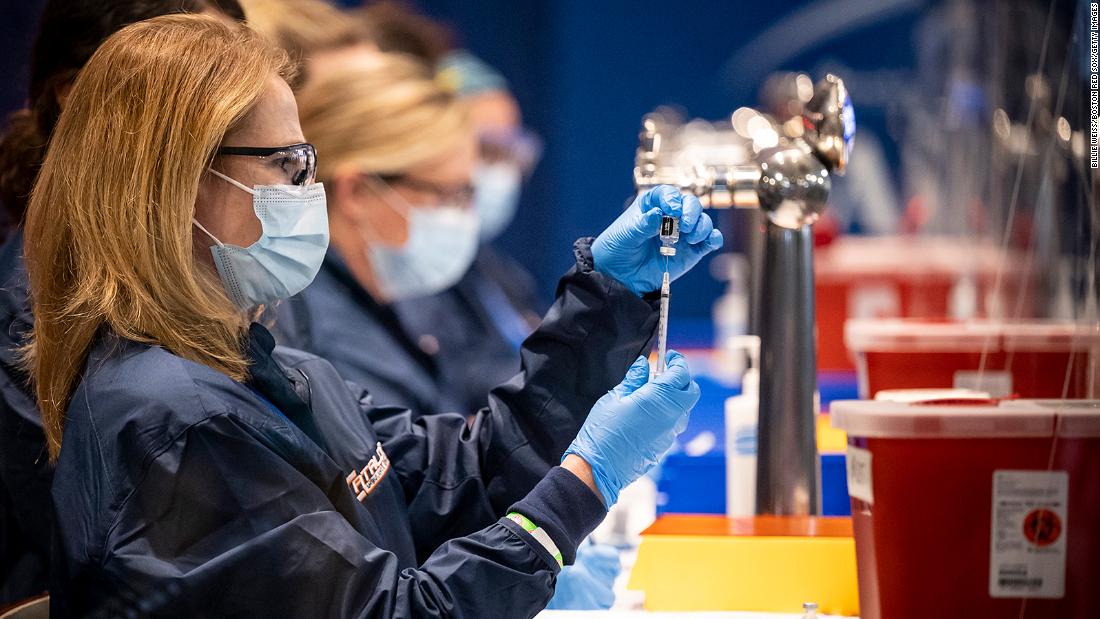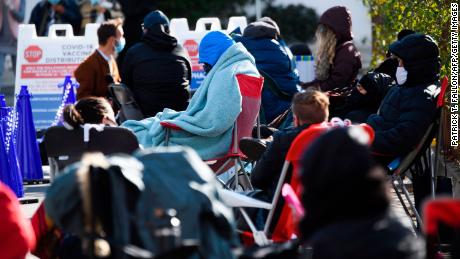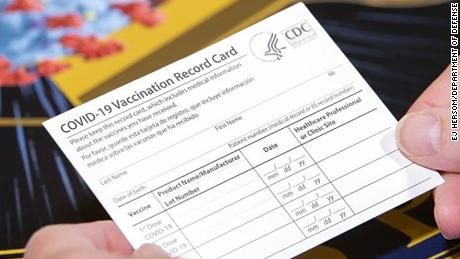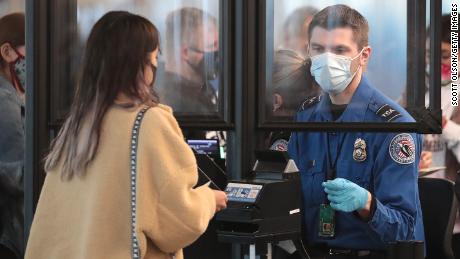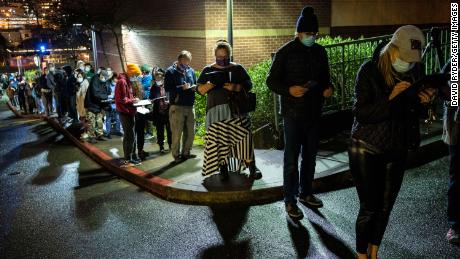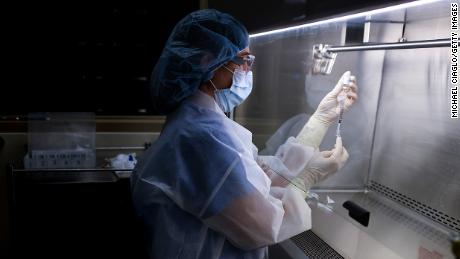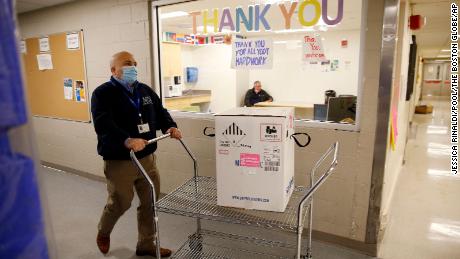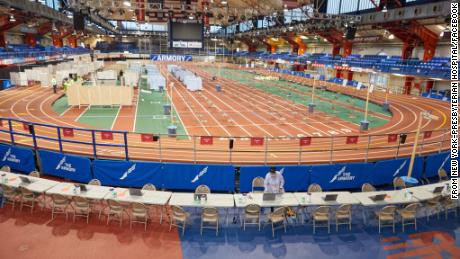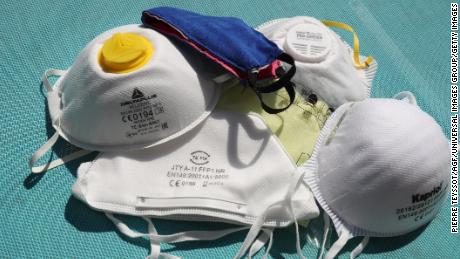The US is in an ‘absolute race against time’ with new coronavirus variants, expert says
“Right now we are in an absolute race against time with these variants, with trying to get people vaccinated before they spread too much across our country. It means that just going to the grocery store, to school or to work could become more dangerous. We have an already overtaxed and exhausted health care system.”
“Despite the falling numbers, now is not the time to let up on the basic precautions,” Ranney warned. “Wear a mask, avoid indoor unmasked gatherings, and of course, wash your hands and try to maintain a distance from others when possible.”
“We have a little breathing room right now,” she said. “But if these new variants become dominant in our country, we are going to be right back where we were in November and December — and perhaps even worse.”
The debate over how to vaccinate
About 5.6 million people have been fully vaccinated with both doses. That’s 1.7% of the US population.
But with new variants spreading, some health experts say the US should go ahead and give first doses to as many people as possible — even if that might delay second doses for others.
“We still want to get two doses in everyone,” Dr. Michael Osterholm, director of the Center for Infectious Disease Research and Policy at the University of Minnesota, told NBC on Sunday.
“But I think right now, in advance of this surge, we need to get as many one doses in as many people over 65 as we possibly can to reduce serious illness and deaths that are going to occur over the next weeks ahead.”
“The surge that is likely to occur with this new variant from England is going to happen in the next six to 14 weeks,” Osterholm said.
“And if we see that happen … we are going to see something like we have not yet seen in this country.”
But some health experts are concerned second doses could be delayed. Recipients of the Pfizer/BioNTech vaccine are supposed to get their second doses 21 days after the first dose, and the Moderna vaccine doses are supposed to be spaced 28 days apart.
The World Health Organization and both manufacturers have said people can wait as long as six weeks between doses. But Pfizer and Moderna also said they don’t have any data on how long people can wait between doses and still get good protection.
While Osterholm’s idea is “admirable, trying to give at least some protection to as many people as possible,” it also has drawbacks, said William Haseltine, president of Access Health International.
“First, they may not get fully protected, and that might accelerate the rate of variants taking over and causing us much more trouble in the future,” said Haseltine, a former professor at Harvard Medical School.
“Secondly, we really don’t know if delaying the second dose for a long time is going to give you the same degree of protection as putting the two doses at the same time.”
There is some “wiggle room” in the time between when people get their two doses Dr. Anthony Fauci said Monday.
Ideally, people should stick to the recommended interval of either three weeks or four weeks, said Fauci, director of the National Institute of Allergy and Infectious Diseases.
“But if someone who, for one reason or another, is a bit late by a couple of weeks … there is some wiggle room,” Fauci said.
“It’s not the end of the world if you delay a little bit. If you want to delay it by six months, that’s different.”
States should not be holding back doses to give people their second shot, Fauci said.
“Better in somebody’s arm than in a freezer or refrigerator, so long as you have confidence that the flow and the cadence of doses will not have people who get their first dose miss their second dose,” Fauci said.
Ranney hopes increased production can help ensure people can get their second doses in a timely manner, she said.
“Give everyone the doses that you can right now and count on that increased production so that you can get people adequately protected.”
Johnson & Johnson may have millions of doses soon
Many Americans are hoping Johnson & Johnson’s Covid-19 vaccine will get emergency use authorization from the Food and Drug Administration this month.
That vaccine has been shown to be 66% effective in preventing moderate and severe disease in a global Phase 3 trial and 85% effective against severe disease, the company announced Friday. The vaccine was 72% effective against moderate and severe disease in the US.
There are two key advantages to the Johnson & Johnson vaccine. It only requires one dose, and it can be kept at normal refrigeration temperatures.
If the vaccine gets a green light from the FDA in the coming weeks, Johnson & Johnson said it would have fewer than 10 million vaccine doses available, a federal health official told CNN.
The number of doses available would be in the single-digit millions and that number would ramp up to 20 or 30 million doses by April, the official said. CNN has reached out to Johnson & Johnson for comment.
More fully at-home Covid-19 tests will be available
The US government is working with the Australian company Ellume to provide more of its fully at-home Covid-19 tests to the United States, the Biden administration said Monday.
“Ellume has been ramping up manufacturing and will ship 100,000 test kits per month to the US from February through July,” said Andy Slavitt, senior White House adviser for Covid-19 response.
With a new $230 million contract, Ellume will “be able to scale their production to manufacture more than 19 million test kits per month by the end of this year, 8.5 million of which are guaranteed to the US government,” Slavitt said.
The Ellume test can detect Covid-19 with 95% accuracy in about 15 minutes, he said.
This antigen test, sold over the counter, can be done at home using a nasal swab, dropper and processing fluid. The test uses an analyzer that connects with a software app on your smartphone to help you perform the test and then interpret your results all from home, similar to at-home pregnancy tests.
States face problems with vaccine supply
“If we have three problems, it’s supply, supply and supply,” Kentucky Gov. Andy Beshear said.
While the state has the capacity to give 250,000 first doses a week, Beshear said, it’s only scheduled to get about 64,000 doses — a shortfall he said other states face, too.
“The only thing that’s keeping us from defeating this virus next month is the amount of supply we get.”
New York City Mayor Bill de Blasio highlighted preliminary data Sunday showing a clear racial disparity among New Yorkers who have so far received vaccine doses.
“Clearly what we see is a particularly pronounced reality of many more people from White communities getting vaccinations than folks from Black and Latino communities,” de Blasio said.
In response, the city expanded its list of neighborhoods that have been hardest hit by the virus and will ramp up outreach, prioritize appointments and add new vaccine sites in those areas, among other efforts, the mayor said.
The disparity, de Blasio said, needs to be “addressed aggressively and creatively.”
The CDC offers tips for Super Bowl Sunday
One of the biggest celebrations of the year is coming up this weekend — just as health officials beg Americans to hunker down to help stop the spread of new strains.
“The safest way to watch the Super Bowl this year is at home with people you live with,” the CDC said.
If you insist on having a small watch party, host it outdoors and make sure everyone has a mask.
“Use a projector screen to broadcast the game. Sit at least 6 feet away from people you don’t live with,” the CDC says.
Going to watch parties or other larger events should provoke extra precautions, the agency said. In addition to wearing a mask:
— Call the venue in advance to make sure it’s taking safety precautions
— Avoid the restroom and concession areas during busy times, such as at halftime or right after the game
— Avoid chanting or cheering, as both can hurl viral particles into the air. “Stomp, clap, or bring hand-held noisemakers instead,” the CDC says.
CNN’s Maggie Fox, Naomi Thomas, Kaitan Collins and Ganesh Setty contributed to this report.
![]()


